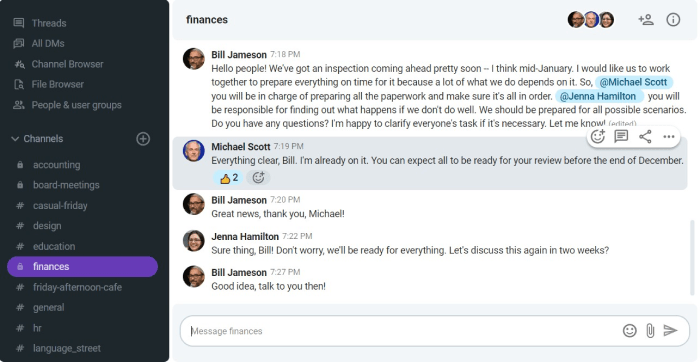Did you know that the former president and CEO of the Ford Motor Company, Alan Roger Mulally, a great visionary leader, managed to save and transform the company thanks to his vision?
How did he do that?
As a visionary leader, he guided his followers toward a shared vision. If you’re not sure what exactly visionary leadership means, you’re in the right place.
In this blog post, we’ll delve deeper into the topic of visionary leadership and find out:
- What this type of leadership implies,
- What the main pros and cons of visionary leadership are, and
- What the key qualities of a visionary leader are.
Plus, we’ll discuss some real-life examples of visionary leadership, and share expert tips on how to gain visionary leadership skills.
So, let’s start!

Table of Contents
What is visionary leadership?
Visionary leadership is a management style where a leader focuses on:
- Creating a vision and
- Inspiring followers to progress toward it.
As such, this leadership style provides long-term objectives and gives the followers a sense of purpose, which guides them toward the vision.
What is a visionary leader?
Visionary leaders have a clear idea of a long-term plan for the future and communicate their vision to their followers.
By doing that, these leaders foster team communication and collaboration and inspire team members to pursue a common goal.
Thus, visionary leaders ensure the vision turns into reality by:
- Defining specific goals,
- Making a strategic plan for achieving them, and
- Inspiring and helping each team member to take action on the plan.
Visionary leadership principles
To achieve their goals in a sustainable and effective way, visionary leaders follow these 5 principles:
- Building vision ― Visionary leaders create a shared goal and make sure all the employees have the same understanding about tracking the progress.
- Nurturing collaboration ― Fostering team collaboration is a key factor for success.
- Promoting performance ― The responsibility of creating a work environment that promotes performance falls onto the visionary leader.
- Cultivating learning ― Visionary leaders help their employees boost their performance by encouraging them to improve their knowledge and skills accordingly.
- Ensuring results ― By incorporating the first 4 principles, visionary leaders ensure that the desired results are achieved.
Visionary leadership characteristics
Visionary leaders don’t just lead their teams, they often bring great innovations such as launching new products.
But how do they achieve that?
Aside from hard technical business skills, they also have to possess a skill set that can help them build long-term strategies and lead others toward the shared goal.
So, here are the most important characteristics every successful visionary leader has:
- Enthusiasm,
- Strategic thinking,
- Resilience,
- Emotional intelligence,
- Growth mindset,
- Strategic risk-taking, and
- Strong communication skills.
So, let’s see why these characteristics reflect the success of visionary leaders.
Practice your leadership communication skill in Pumble
Characteristic #1: Enthusiasm
One of the most important characteristics of visionary leaders is their enthusiasm for the vision.
Sharing enthusiasm and passion about the common goal is a powerful way to foster commitment and engage team members to take action toward the vision.
Since the passion for the vision is contagious, enthusiastic leaders can truly influence their followers and make them feel the same.
Characteristic #2: Strategic thinking
Of course, passion itself is not sufficient ― enthusiasm without direction is most likely to be misguided.
To make their vision become reality, visionary leaders have to make a strategic plan that helps both the leader and the followers to move toward the vision.
Characteristic #3: Resilience
All leadership styles require a high level of resilience ― the capacity to successfully adapt to challenging situations.
As visionary leaders typically encounter obstacles on their way toward the vision, resilience is a powerful way to stay determined and deal with difficulties.
Characteristic #4: Emotional intelligence
To be a great visionary leader, it’s important to be aware of your own and others’ emotions.
Only when you recognize other people’s emotions can you influence them, and, consequently, make others want to follow your vision.
💡 PUMBLE PRO TIP
Emotionally intelligent people work better in a team, which helps them communicate and collaborate more effectively. To learn how to improve your emotional intelligence in the workplace, make sure to read our blog post:
Characteristic #5: Growth mindset
Since leadership is a challenging journey with ups and downs, the way visionary leaders perceive failure is critical.
Seeing failure as an opportunity to learn and grow is essential for a visionary leader’s success.
With a growth mindset, leaders overcome obstacles with resilience and inspire their followers to do the same.
Characteristic #6: Strategic risk-taking
Another quality of a successful visionary leader is strategic risk-taking, which helps them make an impact.
However, visionary leaders take calculated, smart risks. In other words, they take risks that make strategic sense.
To increase risk tolerance, it’s important to be aware of potential gains and losses when taking a risk and make a plan B.
Characteristic #7: Strong communication skills
Strong communication skills are undoubtedly must-have skills for visionary leadership.
According to a Harvard Business Review survey of 136 managers, leaders who effectively communicate their vision have followers who are more committed to the shared goal.
Even when it comes to small tasks or projects, a visionary leader will clearly communicate and inspire others to engage, as shown on the Pumble example bellow.

Therefore, to make the followers more engaged and dedicated, it’s important to clearly communicate what the team is working toward.
💡 PUMBLE PRO TIP
If you’re not sure how to improve your leadership communication skills, make sure to check out our blog posts:
Visionary leadership examples
Now that we know the most important traits and skills of a successful visionary leader, it’s a good moment to look at how leaders change their industry thanks to their visions.
Example #1: Andrew Carnegie, industrialist and philanthropist
“No man will make a great leader who wants to do it all himself or get all the credit for doing it.”
Considered one of the wealthiest Americans in history, Andrew Carnegie founded the Carnegie Steel Company which later became the US Steel Corporation.
As he led the expansion of the American steel industry, Carnegie is known as the father of modern steel who received many awards and honors throughout his career.
Beyond that, Carnegie made great charitable and philanthropic efforts after he retired ― he believed that money should be used to service society.
Example #2: Alan Roger Mulally, former President and CEO of the Ford Motor Company
Alan Mulally was No.3 on Fortune’s list of World’s Greatest Leaders in 2014, and listed as one of the 30 World’s Greatest Leaders by Barron’s magazine in 2010.
He believes that teamwork, cooperation, and building trust are critical to success. Most importantly, he believes in the power of a compelling vision.
Mulally’s vision was:
“People working together as a lean global enterprise for automotive leadership.”
Thanks to this belief, he managed to save Ford from bankruptcy during the big economic crisis.
Mulally has pointed out that compelling vision can give people meaning:
“Leadership is having a compelling vision, a comprehensive plan, relentless implementation, and talented people working together. People also want meaning. All of us want to know that we are doing great things, that we are touching a lot of people, and that what we are doing is about something bigger than ourselves.”
Example #3: Sam Walton, Walmart Founder
Sam Walton is recognized as one of the greatest visionary leaders in history.
His retail industry journey started back in 1962 when he opened his first store in a small town in Arkansas. Only 5 years later he had 20 locations.
He was known for saying:
“Capital isn’t scarce, vision is.”
From the very beginning, he had a clear vision and knew what he wanted. What’s more, Walton was a risk-taker and ready to invest his money and time in new ventures.
Example #4: Reed Hastings, the Co-Founder and CEO of Netflix
“Companies rarely die from moving too fast, and they frequently die from moving too slowly.”
Reed Hastings is considered a visionary leader in the entertainment industry.
Before the streaming tech even existed, Hastings had a vision to turn the existing business model from a DVD rental into a streaming service.
His great confidence to take risks contributed to Netflix’s rapid transformation into the world’s best streaming company, which currently has more than 238 million paid subscribers worldwide.
Pros of visionary leadership
Aside from creating a vision that may lead to revolutionary changes, visionary leaders also make an impact on their followers.
Let’s go over the most important benefits of visionary leadership that make this leadership style outstanding.
Pro #1: Visionary leadership inspires followers
Inspiration is typically connected to people’s feelings and values. As such, it’s a more powerful driving force than motivation.
We spoke to Sean Stewart, a Business Consultant and Leadership Expert. He highlights that visionary leaders have a greater impact on people:

“Having a vision is clearly an effective way to inspire, and inspiration is usually more effective than mere motivation. It’s easier to inspire people who actually want to create the same world as the leader does.”
Pro #2: Visionary leadership connects people
Visionary leadership is a great way to make people unite around a shared vision.
When people have common goals, they feel more connected, and, consequently, they communicate and collaborate more effectively.
In other words, creating a shared vision helps everyone be on the same page and fosters a sense of unity.
Connect with your teammates over Pumble
Pro #3: Visionary leadership contributes to innovative solutions
As visionary leadership includes fostering team creativity and creating a vision, it empowers a company with effective solutions.
This way, companies can replace outdated practices with innovative approaches, which can make them outstanding and improve brand recognition.
Cons of visionary leadership
Even though visionary leadership style has contributed to great revolutionary changes in various industries, there are also some cons we should consider.
Con #1: Visionary leadership may overlook short-term goals
As we said, visionary leaders are focused on long-term goals, which can cause problems when it comes to achieving short-term goals.
According to Julie Jungalwala, a Leadership Instructor at Harvard and Leadership Coach, visionary leaders often get overwhelmed with the bigger picture of their vision and overlook day-to-day operations:

“Visionaries may occasionally overlook operational details, causing implementation hurdles. They may appear to ‘have their head in the clouds’ and unable to flex to address critical operational details in the case of an emergency or crisis.”
Con #2: Visionary leadership may be too idealistic
Visionary leaders are often too idealistic and tend to push for unrealistic goals.
Our contributor, Julie Jungalwala, is well aware that unrealistic leaders’ expectations can have a negative impact on the followers:

“Setting exceedingly ambitious goals can inadvertently generate unrealistic expectations, which, if unmet, can disappoint stakeholders.”
Sean Stewart adds that visionary leaders tend to focus solely on their vision and overlook other aspects of the business:

“Such leaders tend to develop tunnel vision and see only what they wish to see. Data which contradicts the vision tends to be explained away or wished away.”
Con #3: Visionary leadership may be perceived as unreliable
Some visionary leaders might have great visions, but don’t know how to communicate them effectively to their followers.
Therefore, they may be perceived as unqualified leaders, which can lead to disconnection between leaders and their teams.
As a result, it may be difficult to gain the trust of the followers and inspire them to progress toward the vision.
3 Expert tips on how to gain visionary leadership skills
Being a good visionary leader is not something you are born with. Instead, visionary leadership entails a set of skills and a growth mindset that affects others.
So, if you’re wondering how you can develop visionary leadership skills, here are some tips that leadership experts shared with us.
Tip #1: Have the right team
It doesn’t matter how inspiring your vision is — if you don’t have the right people who will follow the vision, you won’t achieve your goals.
Our contributor, Sean Stewart is well aware of the importance of having the right team that is aligned with the vision:

“One of the essential skills that visionary leaders need is learning how to recruit those who are fulfilled by what it is they are trying to create.
Simply enthusing them is rarely enough. Motivating them is often too short-term and ineffectual.
You, as the leader, need to find those whose heart races in the same way yours does when you think about and plan the project. You’re looking for the sharing of the same or similar innate sense of purpose here.
You want to be able to not only delegate responsibility for aspects of the project to subordinates, but also to confidently devolve some of your authority to those below you.”
What Sean advises is asking yourself several questions when hiring staff:

“Ask yourself, is this somebody I can delegate some of my authority to and know that the person will drive forward to the common goal without abusing or misusing that authority?
If the answer is yes, then it’s likely a good match. This skill is often overlooked, but it’s vital. So anything you can do to gain practice in evaluating what fulfills people will prove to be useful.”
Tip #2: Learn continuously
As we discussed, successful visionary leaders have a growth mindset, which helps them consider failure as an opportunity to develop and learn something new.
Julie Jungalwala emphasizes that continuous learning is essential for visionary leadership as well as building risk tolerance:

“Commit to continuous learning and sharpening of your ability to see the future, convey its potential, and enable others to act on it. How? By staying ahead of industry trends and global issues, building your communication skills to master the art of conveying your vision persuasively, and embracing empathy, which is vital for building strong relationships.”
Jungalwala also highlights the importance of building risk tolerance and fostering team creativity:

“Develop your strategic acumen by tackling complex challenges and seeking innovative solutions. Gradually build your risk tolerance by embarking on smaller, calculated ventures. Encourage diverse perspectives within your team to foster creativity and cultivate resilience by learning from failures and setbacks.”
Tip #3: Develop the ability to be discerning
Another critical step for becoming a better visionary leader is to learn how to discern the current situation and understand what the vision will accomplish.
Sean Stewart believes that developing this skill is challenging and requires significant time and effort, but is essential for sustainable success:

“In terms of traditional skills, probably the most important skill to have is the ability to not only be good at analysis but also have the ability to discern where we are now and how to articulate what your vision will accomplish in terms of bringing the things you discerned into reality. You have to understand both the present situation and what the future will be like when your product or innovation hits the market.”
To develop the ability to be discerning, Stewart recommends reading philosophy and history:

“Probably the best way to develop your ability to be discerning and to understand consequences is to read a good deal of history or philosophy. The mind — the imagination — is like a muscle. It takes constant practice and stimulation to develop this ability.
So, start reading on a topic outside of business that interests you, and keep at it. Teach it to others. Write about it. The more you do this type of thing, the better you position yourself to be an innovative, visionary leader.”
Wrapping up: Visionary leadership creates a sense of purpose
As Warren Bennis said: “Leadership is the capacity to translate vision into reality”.
To be a successful visionary leader, you need to not only develop visionary leadership skills, but also find the right people who will commit to your vision.
Aside from that, visionary leaders have to clearly define their goals and make a strategic plan to achieve them.







